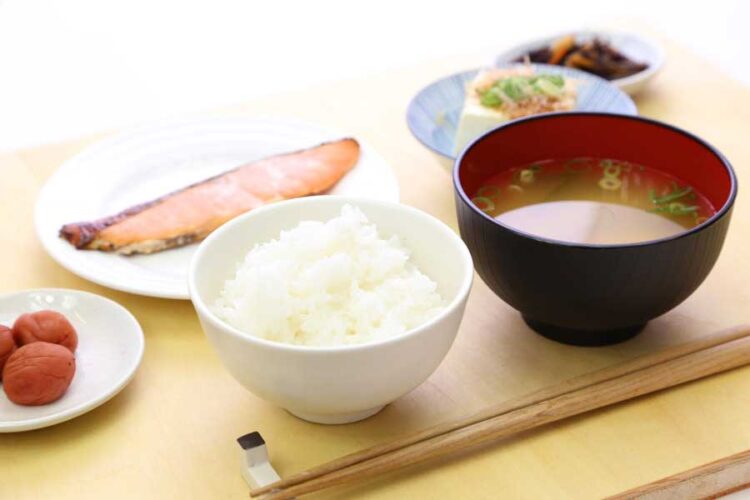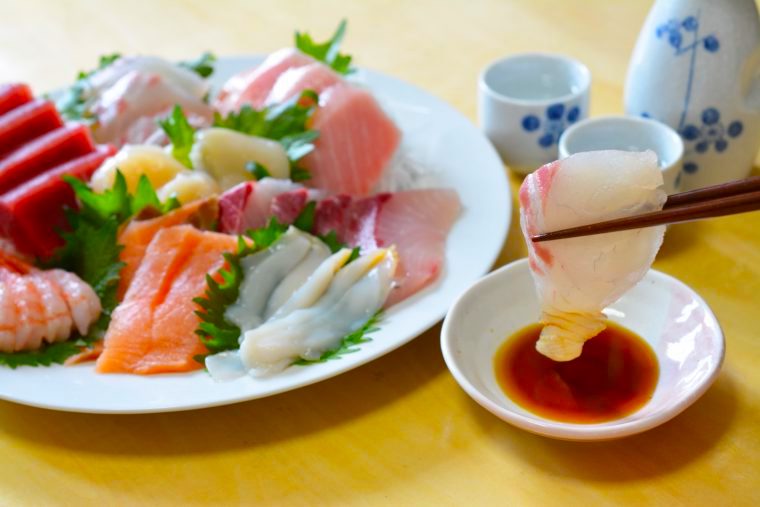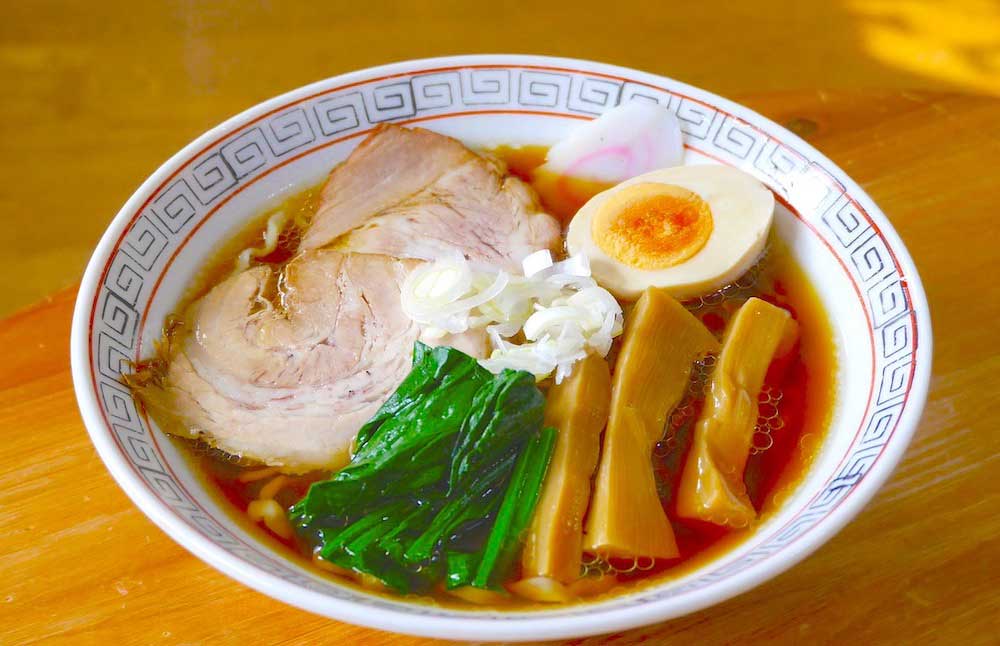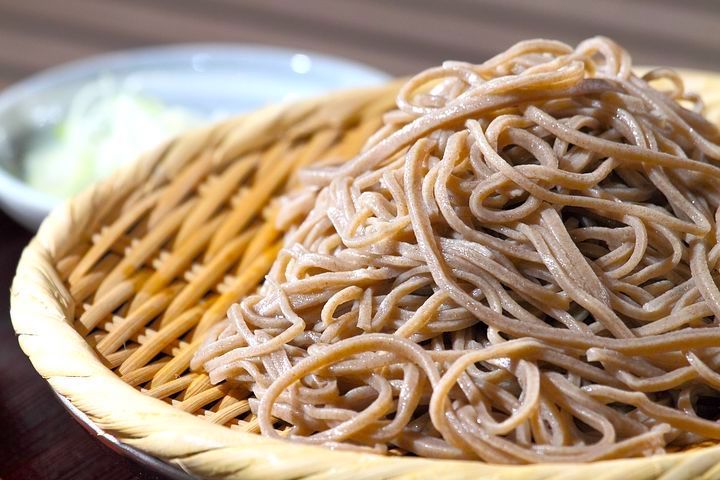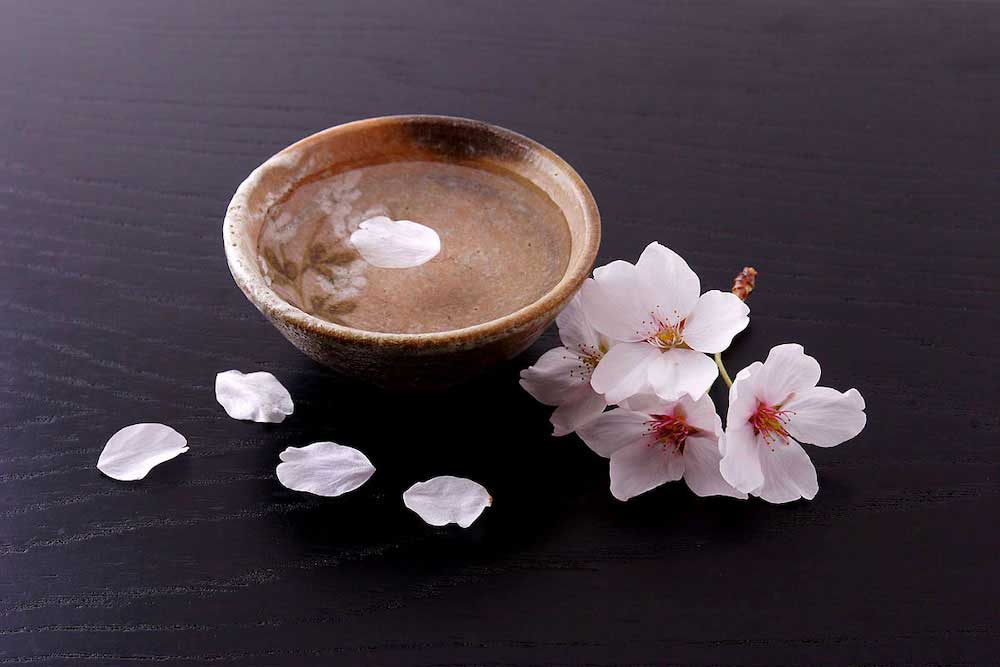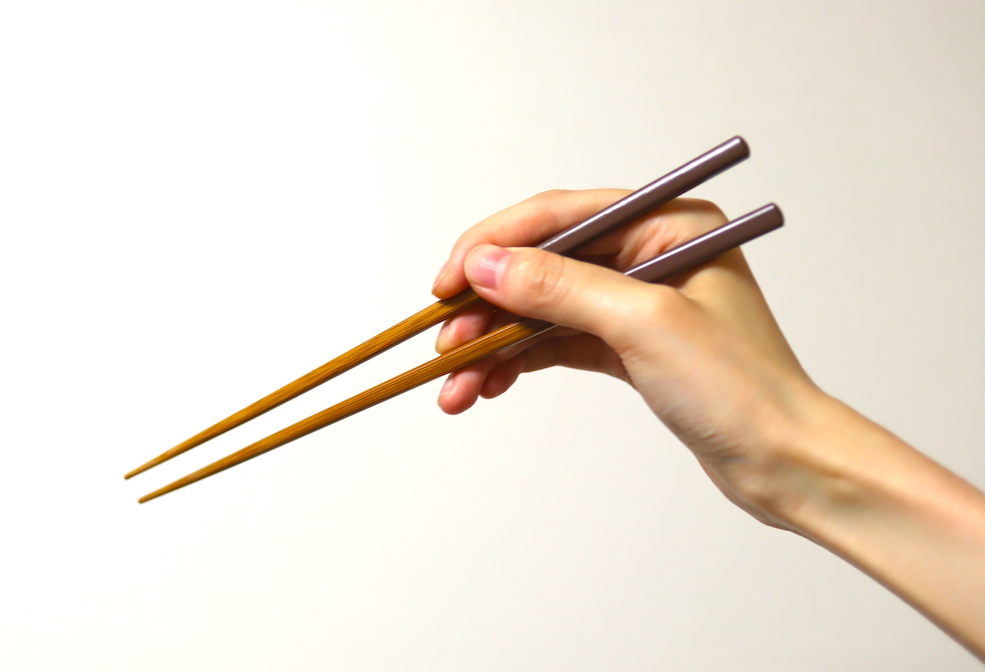
日本人の和のこころ、お箸。
なぜ、お箸を正しく持てたほうがいいのでしょうか。
お箸を正しく持ちますと、5本指の所作が最も美しく、また食べ物をいただく上で主要な動作である「つまむ」を、どこにも無駄な力を入れることなく容易にすることができます。
実際に見てみると分かりますが、動かすのは人差し指と中指だけで、他の3本の指はそっと添えているだけなのです。
お箸に限らず、昔から作法とされているものは理にかなっていることが多く、農耕民族が長い歴史の中で培ってきた美意識と、生命を司る食べ物に対する畏敬の念が、この無駄のない所作に反映されていると言っても過言ではありません。
今回は、お箸の持ち方はもちろん、注意点やエチケットなどについて英語で説明する表現をご紹介していきますので、ご参考になれば幸いです。
ご興味のある方は、当サイトで 英語クイズ(5000問) を出題しておりますので是非ご覧ください。
目次
お箸の簡単な説明
In Japan, meals are mainly eaten with “hashi,” which are called chopsticks in English.
(日本では主に、英語で chopsticks と呼ばれる「箸」を使って食事をします。)
Japanese chopsticks are usually made of wood or bamboo.
(日本のお箸は、ふつう木や竹でつくられています。)
There are also disposable wooden chopsticks that are split into two.
(2つに割る、木でできた使い捨てのお箸もあります。)
Chopsticks are not only used when eating rice and side dishes but also noodles, like soba and udon.
(お箸はご飯やおかずだけでなく、お蕎麦やうどんなどの麺料理を食べる時にも使われます。)
If you can hold chopsticks properly, you can fully enjoy Japanese cuisine.
(お箸を正しく持つことができれば、日本料理を存分に楽しむことができます。)
If you can use chopsticks correctly, you should easily be able to grasp small objects such as beans or grains of rice one at a time.
(お箸を正しく持てるようになると、お豆やお米粒などの小さなものも一粒ずつ一回で簡単につまめるようになります。)
You have to lift “ochawan” (a rice bowl) or “owan” (a miso soup bowl) from the table when eating.
(食べる時はお茶碗やお椀をテーブルから持ち上げます。)
You should not put your elbow on the table while eating.
(食事中にテーブルに肘をつかないようにしましょう。)
You should not leave a single grain of rice in your bowl.
(お茶碗には、ごはん粒を残さないようにしましょう。)
“If it can’t be eaten with chopsticks, it’s not genuine Japanese food.”
(箸で食えないものは真の日本食にあらず。)
お箸の持ち方 / How to hold chopsticks
お箸は、次のたった2つの工程だけで正しく持つことができます。
Step 1. Hold a stick like a pencil
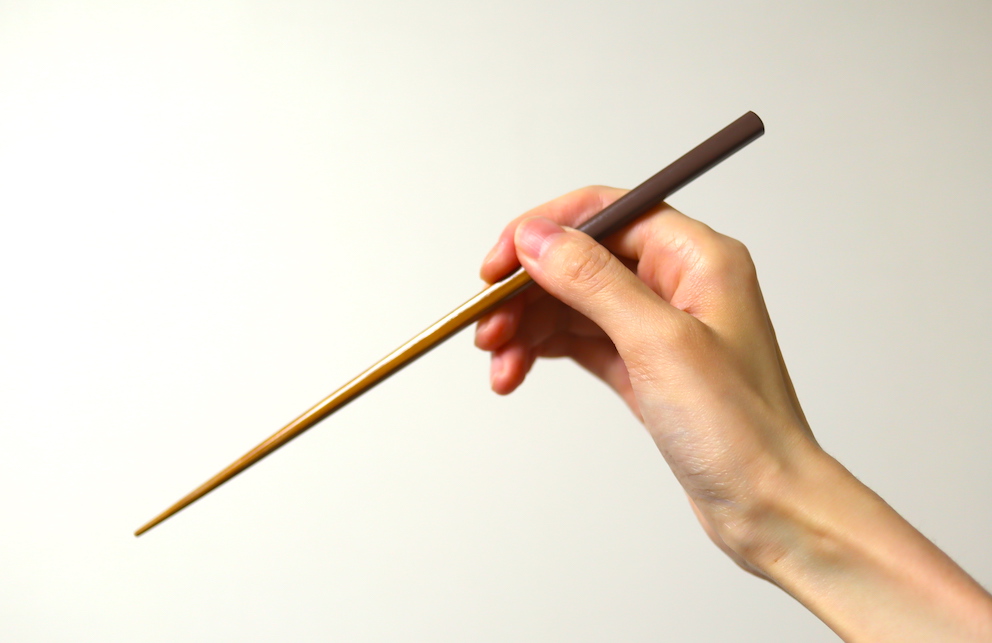
Pick up a single chopstick and hold it between your thumb and your index finger, like a pencil.
(1本のお箸を手にとって、鉛筆のように親指と人差し指で持ちます。)
This is how to hold the upper chopstick.
(これが上のお箸の持ち方です。)
Step 2. Insert the second stick
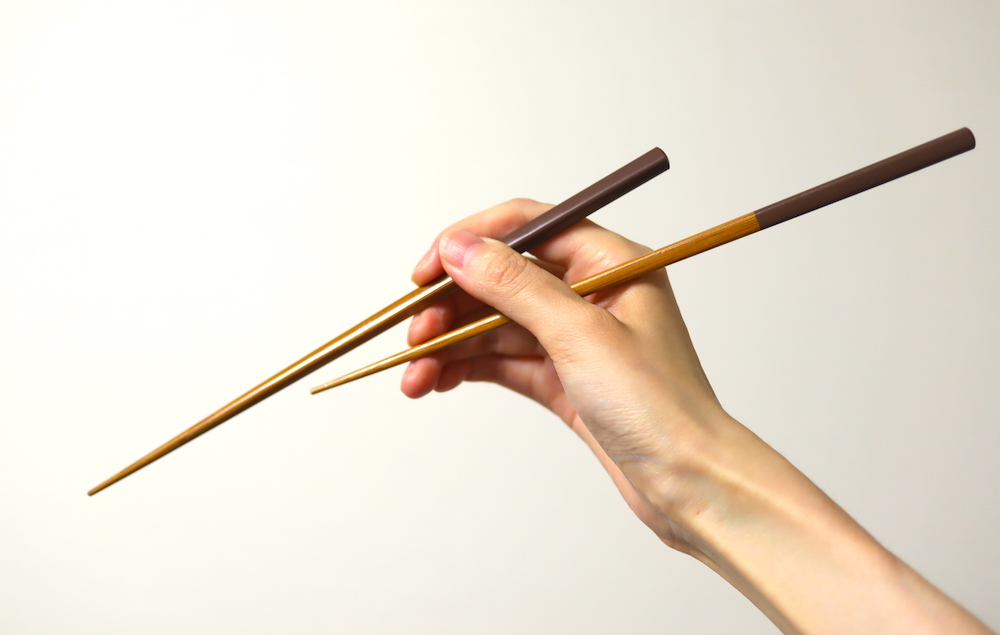
Next, take the second chopstick, slip it between the upper stick and the base of your thumb so that it is touching the third finger, and then line up the tips of the chopsticks.
(次に、2本目のお箸を1本目のお箸と親指の付け根の間に滑り込ませ、薬指に触れるようにしてから、お箸の先端を揃えます。)
Step 3. Done!

This is considered the easiest and most elegant way to hold chopsticks.
(これが、最も簡単で上品なお箸の持ち方とされています。)
Move the upper chopstick with your index and middle fingers.
(上のお箸を、人差し指と中指を使って動かしてみてください。)
In grasping food items, only the upper chopstick should be moved up and down.
(食べ物をつまむときは、上のお箸だけを上げ下げするようにします。)
This time, try not to move the bottom chopstick.
(このとき、下のお箸を動かさないようにしましょう。)
Some points to consider / 留意点
Chopsticks should be held at about two-thirds of the length up from the tips.
(先端から3分の2くらいの長さの位置で持つようにします。)
The upper stick should be supported by the first joint of the middle finger.
(上のお箸は、中指の第一関節で支えるようにします。)
The bottom stick should be naturally supported by the third finger and the little finger.
(下のお箸は、薬指と小指で自然に支えるようにします。)
When you use chopsticks, don’t move your thumb or your third finger which is holding the bottom stick.
(お箸を使うときは、下のお箸を持つ親指と薬指は動かさないようにします。)
Keep chopsticks in a parallel position and avoid crossing them.
(お箸は平行になるようにし、交差することは避けるようにします。)
お箸の間違った使い方 / Japanese Chopsticks Taboos
There are a few taboos regarding chopsticks.
(お箸の使い方に関して、タブーとされているものがいくつかあります。)
“Hahiutsushi” and “Tatebashi” are associated with funeral customs.
(「箸移し」と「立て箸」は、お葬式のしきたりに結びついています。)
箸移し / Hashiutsushi
Never pass food directly from your chopsticks to another person’s chopsticks.
(自分のお箸から他人のお箸に直接食べ物を移してはいけません。)
This resembles a custom at Japanese funerals when cremated bones are ceremoniously transferred to the urn.
(これは、日本のお葬式において、火葬された骨を骨壺に移すときの儀式に似ています。)
It is considered the biggest taboo at the Japanese dinner table.
(日本での食事の席においては、最もしてはいけないこととされています。)
立て箸 / Tatebashi
You should not stick chopsticks upright into a bowl of rice, as it looks like an offering to a dead person.
(お箸をお茶碗のご飯に縦に刺してはいけません。これは亡くなった方へのお供えのように見えてしまいます。)
迷い箸 / Mayoibashi
When the table is filled with delicious-looking dishes, you may wonder what to pick first. But you should not wave your chopsticks above food while deciding what to eat.
(テーブルの上が美味しそうなお料理でいっぱいですと、何を最初に食べようか迷ってしまうことでしょう。しかし、決めかねているときに食べ物の上でお箸をうろうろさせてはいけません。)
刺し箸 / Sashibashi
You should not stab food with your chopsticks.
(お箸で食べ物を刺してはいけません。)
寄せ箸 / Yosebashi
You should not use your chopsticks to pull dishes toward you.
(食器を自分のほうへ寄せるときにお箸を使ってはいけません。)
ねぶり箸 / Neburibashi
You should never lick your chopsticks.
(お箸を舐めてはいけません。)
指し箸 / Sashibashi
You should not point at someone or something with chopsticks.
(お箸で人や物を指したりしてはいけません。)
探り箸 / Saguribashi
You should not dig in a bowl to find a piece of food.
(お箸で器の中の食べ物を探ってはいけません。)
涙箸 / Namidabashi
You should not carry food dripping from soup or sauce with your chopsticks.
(お箸から汁やソースなどを垂れさせた状態で食べ物を口に運んではいけません。)
ちぎり箸 / Chigiribashi
You should not hold each chopstick in a different hand and use them to tear food apart.
(お箸を左右の手に持って、食べ物をちぎったりするのに使ってはいけません。)
